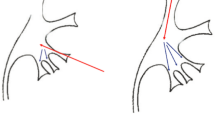Abstract
The objective of this study is to assess the efficacy of superior calyceal access versus inferior calyceal access for inferior calyceal calculi with or without pelvic calculi. A total of 100 patients with inferior calyceal calculi or inferior calyceal calculi with pelvic calculi were included in this prospective randomized study. In 50 patients (Group 1), a fluoroscopy-assisted superior calyceal puncture was made, and in other 50 patients (Group 2), access was obtained through a fluoroscopy-assisted inferior calyceal puncture. The stone-free rates, hemoglobin drop, operative duration, requirement for additional tracts, complications, and auxiliary procedures in the two groups were compared. Stone clearance rates and hemoglobin drop values were better in group 1, though they were not statistically significant. The mean operative duration, number of tracts required, and the relook procedure rate were significantly in favor of Group 1. Only one patient (2 %) in Group 1 developed hydropneumothorax related to supracostal puncture and required intercostal tube drainage. Superior calyceal puncture (supracostal or infracostal) provides favorable access to inferior calyceal stones, providing better and faster clearance with less requirement of secondary tracts and auxiliary procedures.
Similar content being viewed by others
References
Srisubat A, Potisat S, Lojanapiwat B, Setthawong V, Laopaiboon M (2009) Extracorporeal shock wave lithotripsy (ESWL) versus percutaneous nephrolithotomy (PCNL) or retrograde intrarenal surgery (RIRS) for kidney stones. Cochrane Database Syst Rev 4:CD007044
Turk C, Knoll T, Petrik A, Sarica K, Straub M, Seitz C (2011) Guidelines on urolithiasis. European Association of Urology Update. http://www.uroweborg/gls/pdf/20_Urolithiasis_LR%20March%2013%202012.pdf. Accessed 8 Aug 2013
Galvin DJ, Pearle MS (2006) The contemporary management of renal and ureteric calculi. BJU Int 6:1283–1288
Preminger GM, Assimos DG, Lingeman JE, Nakada SY, Pearle, Wolf JS Jr (2005) AUA nephrolithiasis guideline panel. Chapter 1: AUA guideline on management of staghorn calculi: diagnosis and treatment recommendations. J Urol 173(6):1991–2000
Albala DM, Assimos DG, Clayman RV et al (2001) Lower pole I: a prospective randomized trial of extracorporeal shock wave lithotripsy and percutaneous nephrostolithotomy for lower pole nephrolithiasis-initial results. J Urol 166(6):2072–2080
Wen CC, Nakada SY (2007) Treatment selection and outcomes: renal calculi. Urol Clin North Am 34(3):409–419
McDougall EM (2002) Percutaneous approaches to the upper urinary tract. In: Walsh PC et al (eds) Campbell’s urology, 8th edn. Sanders, Philadelphia, pp 3320–3360
Elbahnasy AM, Clayman RV, Shalhav AL, Hoenig DM, Chandhoke P, Lingeman JE et al (1998) Lower-pole caliceal stone clearance after shockwave lithotripsy, percutaneous nephrolithotomy, and flexible ureteroscopy: impact of radiographic spatial anatomy. J Endourol 12:113–119
Rana AM, Bhojwani JP, Junejo NN (2008) Das Bhagia S. Tubeless PCNL with patient in supine position: procedure for all seasons?–with comprehensive technique. Urology. 71:581–585
Wolf JS Jr, Clayman RV (1997) Percutaneous nephrolithotomy; what is its role in 1997. Urol Clin North Am 24:43–58
Golijanin D, Katz R, Verstandig A, Sasson T, Landau EH, Meretyk S (1998) The supracostal percutaneous nephrostomy for the treatment of staghorn and complex kidney stones. J Endourol 12:403–405
Aron M, Goel R, Kesarwani PK, Seth A, Gupta NP (2004) Upper pole access for complex lower pole renal calculi. BJU Int 94(6):849–852
Adnan Gücük, Eray Kemahlı, Uğ ur yetürk U, Can Tuygun, Mevlüt Yıldız, Ahmet Metin (2013) Routine flexible nephroscopy for percutaneous nephrolithotomy for renal stones with low density: a prospective, randomized study. J Urol 190(1):144–148
Fuchs EF, Forsyth MJ (1990) Supra costal approach for per cutaneous lithotripsy. Urol Clin North Am 17:99–102
Yadav R, Aron M, Gupta NP, Hemal AK, Seth A, Kolla SB (2006) Safety of supracostal punctures for percutaneous renal surgery. Int J Urol 13(10):1267–1270
Author information
Authors and Affiliations
Corresponding author
Ethics declarations
Conflict of interest
None of the authors have any potential conflict of interest.
Ethical approval
No animals were involved in the study. All procedures performed in studies involving human participants were in accordance with the ethical standards of the institutional and/or national research committee and with the 1964 Helsinki declaration and its later amendments or comparable ethical standards.
Informed consent
Informed consent was obtained from all individual participants included in the study.
Rights and permissions
About this article
Cite this article
Singh, V., Garg, Y., Sharma, K. et al. Prospective randomized comparison between superior calyceal access versus inferior calyceal access in PCNL for inferior calyceal stones with or without pelvic stones. Urolithiasis 44, 161–165 (2016). https://doi.org/10.1007/s00240-015-0805-1
Received:
Accepted:
Published:
Issue Date:
DOI: https://doi.org/10.1007/s00240-015-0805-1




